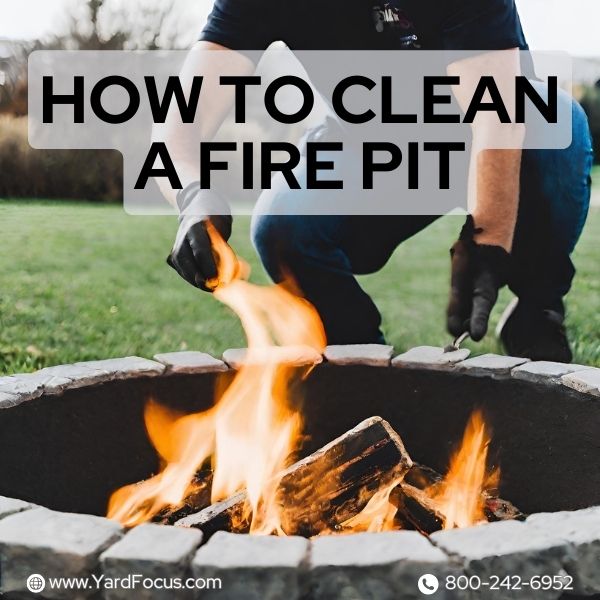
How To Clean A Fire Pit
Enjoying a cozy fire pit on a cool evening becomes a chore when you don't know how to clean a fire pit.
Regular maintenance extends the life of your fire pit and enhances safety.
This blog post guides you through the step-by-step process of cleaning various types of fire pits.
Discover how to maintain your backyard oasis.
When to Clean Your Fire Pit
Clean your fire pit frequently. Ash buildup prevents proper airflow, making igniting fires challenging.

Additionally, accumulated debris poses a fire hazard. Regular cleaning ensures safe operation.
Inspect and clean your fire pit after every use. Let it cool completely before removing the ashes. Sweep out loose debris periodically to prevent buildup.
Deep cleaning with specialized tools is recommended at least once a year or as needed based on the frequency of use.
Necessary Tools for Fire Pit Cleaning
Washing a fire pit requires preparation. Gather suitable tools beforehand.

You need cloths/rags, dish soap, steel wool, white vinegar, a hose pipe or bucket of water, gloves, a shovel, and a heat-resistant bin.
- Cloths and rags help wipe surfaces clean.
- Dish soap cuts through grime and grease.
- Steel wool scrubs stubborn stains and rust.
- White vinegar aids in removing tough residue.
- The hose pipe or bucket provides water for rinsing.
- Gloves protect hands from heat and abrasions.
- A shovel scoops out ashes and debris.
- A heat-resistant bin safely collects hot ashes.
Proper tools streamline the fire pit washing process. The next section discusses cleaning different fire pit materials.
Cleaning Different Types of Fire Pits
Cleaning different types of fire pits varies based on the material they are made of.

Read on for specific cleaning methods for stone, gas, and metal fire pits.
How to Clean a Stone and Masonry Fire Pit
Stone and masonry fire pits require careful cleansing. These fire pits withstand intense heat. Allow the fire pit to cool completely before cleaning.
- First, ensure the fire pit is completely cool. Then, carefully remove loose debris, ash, and unburnt wood pieces using a stiff brush.
- Mix trisodium phosphate with water. Apply this solution to the interior surfaces. Scrub vigorously with a wire brush.
- Rinse the fire pit thoroughly. Use a garden hose to remove all cleaning residue.
- Muriatic acid is a powerful chemical that should be used with extreme caution. Ensure you are working in a well-ventilated area and wearing protective gear such as gloves and eye protection. Always follow local regulations for the disposal of chemical waste to prevent environmental damage.
- Allow the fire pit to dry fully. Check that no moisture remains in crevices.
- Consider resealing the fire pit. Use a heat resistant masonry sealant to protect surfaces.
The next section covers cleaning gas fire pits.
How to Clean a Gas Fire Pit
Gas fire pits require disconnecting the gas supply for cleaning and maintenance.
It's best to always consult the fire pit's manufacturer's instructions before attempting any maintenance to ensure that you are adhering to specific safety protocols.
Cleansing a gas fire pit involves using soapy water or vinegar.
- Turn off the gas supply valve. Disconnect the gas line from the fire pit unit.
- Remove any debris, leaves, or litter from the burner area using a soft brush or vacuum cleaner.
- Mix mild dish soap with warm water to create a cleaning solution. Avoid harsh chemicals.
- Use a soft cloth dipped in the soapy water to wipe down the exterior surfaces.
- For stubborn grime, make a paste with baking soda and water. Gently scrub the affected areas.
- Rinse thoroughly with clean water to remove all soap residue.
- Check for any clogs or obstructions in the burner ports. Use a thin wire brush if needed.
- Inspect the hose and connections for cracks, leaks, or damage. Replace it if necessary.
- Once dry, reconnect the gas line and perform a leak test before using it again.
- Cover the fire pit when not in use to prevent debris accumulation.
How to Clean a Steel or Copper Fire Pit
Steel and copper fire pits require regular washing. Failure to clean them leads to rust and discoloration.
For Steel Fire Pits:
- Allow the fire pit to cool completely before cleaning.
- Use a stiff-bristled brush to remove any loose debris or ash.
- Mix warm water and dish soap in a bucket.
- Dip a soft cloth or sponge into the soapy water.
- Scrub the interior and exterior surfaces of the fire pit.
- Rinse the fire pit with clean water from a garden hose.
- Dry the fire pit thoroughly with a clean cloth.
- Apply a thin coat of high-temperature paint or rust-preventative spray.
For Copper Fire Pits:
- Let the fire pit cool down completely after use.
- Remove any ash or debris with a soft-bristled brush.
- Mix equal parts white vinegar and warm water in a bucket.
- Dip a soft cloth into the vinegar solution.
- Gently scrub the copper surfaces to remove any tarnish or discoloration.
- Rinse the fire pit with clean water from a garden hose.
- Dry the copper surfaces with a clean, soft cloth.
- Apply a thin coat of copper polish or sealant.
Regular maintenance prevents buildup and preserves the appearance of steel and copper fire pits.
Care and Maintenance Tips for Fire Pits
Proper care and maintenance extend a fire pit's lifespan. Use covers and screens to protect your fire pit.

Removing Ashes
Proper ash removal extends a fire pit's life. After the fires cool completely, scoop out the ashes using a shovel or metal bucket.
Spread cooled wood ashes in gardens to enrich the soil after testing your garden's soil pH to ensure compatibility.
Avoid using ashes from treated wood or non-wood materials, as they can contain harmful chemicals.
Only wood ash should be used in gardens, and even then, in moderation.
Ash from treated wood or other materials could contain harmful chemicals and should not be used.
For wood-burning fire pits, remove unburnt wood debris along with ashes. Dispose of ashes responsibly in compost bins or approved areas.
Avoid dumping hot ashes, which risk fire hazards.
Proper Extinguishing Techniques
To extinguish the fire pit safely and completely, gently douse the flames with water or cover them with sand until no embers remain, ensuring all heat sources are fully extinguished.
Spread the ashes to cool them rapidly. This prevents accidental reignition and ensures safe cleaning.
For gas fire pits, turn off the gas supply and let the pit cool fully before cleaning.
While it's important not to douse a hot gas fire pit with water, using a damp cloth for cleaning the exterior surfaces after it has cooled is safe.
Follow the manufacturer instructions for proper extinguishing.
Using Covers and Screens
Protecting the fire pit ensures its longevity. Utilize covers and screens to prevent the accumulation of debris and ash.
These accessories safeguard the pit from elements when inactive, extending its lifespan and maintaining its appearance.
Covers and screens play a vital role in fire pit maintenance.
They shield the structure from weather conditions, minimizing damage and keeping it clean for future use.
Investing in quality covers and screens is a wise decision for fire pit owners.
FAQs
How do I remove debris from my fire pit?
To clean a fire pit, start by removing any debris, garden waste, or leftover firewood using a poker or other tool. This helps prevent the buildup of biochar or patina.
Can I use chemical cleaners on my fire pit?
It's best to avoid using chemical cleaners on fire pits, especially those made of cast iron, Corten steel, or concrete, as they can damage the material or cause rusting.
How do I clean a cast iron fire pit?
For a cast iron fire pit, gently scrub off any built-up residue with a wire brush or grill brush. The patina that develops over time helps protect the metal.
Should I cover my fire pit when not in use?
Yes, using a fire pit cover when not in use can help prevent debris and garden waste from accumulating inside, making cleaning easier.
Can I clean my fire pit, like a fireplace or campfire?
While the cleaning process is similar, fire pits may require more frequent cleaning than fireplaces or campfires due to their open design and exposure to outdoor elements like silicone from wood burning.
Conclusion
Knowing how to clean a fire pit requires using proper tools, techniques, and regular maintenance.
Different materials demand specific cleaning methods to ensure longevity. Proper disposal of ashes benefits gardens and compost piles.
Enjoy future campfires by following the right cleansing process for your fire pit type. Neglecting fire pit cleaning leads to rust, ash buildup, and potential hazards.

